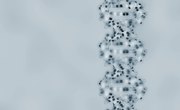
Proteins are among the most important chemicals to all life on the planet. The structure of proteins can vary greatly. Each protein, however, is made up of many of the 20 different amino acids. Similar to the letters in the alphabet, the order of the amino acids in a protein play an important role in how the final structure will function. Proteins can be hundreds of amino acids long, so the possibilities are nearly endless as we will examine within.
How the Amino Acid Sequence is Determined
You may have a general idea that DNA is the genetic basis for everything that you are. What you may not realize is that the only function of DNA is to ultimately determine the order of amino acids that go into all the proteins that make you who you are. DNA is simply long strands of four nucleotides repeating over and over. Those four nucleotides are adenine, thymine, guanine and cytosine and are usually represented by the letters ATGC. No matter how long your DNA is, you body "reads" these nucleotides in groups of three and every three nucleotides codes for one specific amino acid. So a sequence of 300 nucleotides would ultimately code for a 100 amino acid long protein.
Choosing the Amino Acids
Ultimately, your DNA shoots off smaller copies of itself, know as messenger RNA or mRNA, which go to the ribosomes in your cells where proteins are made. RNA uses the same adenine, guanine and cytosine as DNA but uses a chemical called uracil instead of thymine. If you play with the letters A, U, G and C and rearrange them into groups of three, you'll find that there are 64 possible combinations with distinct order. Each group of three is known as a codon. Scientists have developed a chart that allows you to see what amino acid a specific codon codes for. Your body knows that if the mRNA reads "CCU," an amino acid called proline should be added in that spot, but if it reads "CUC," the amino acid leucine should be added. To view an entire codon chart, see the reference section at the bottom of the page.
Different Possibilities of Proteins
A protein can be simply one strand of amino acids, but some complicated proteins are actually multiple strands of amino acids joined together. Additionally, proteins are of different lengths with some being only a few amino acids long and others being over 100 amino acids long. Moreover, not every protein uses all twenty amino acids. A protein could quite possibly be one hundred amino acids long but only use eight or ten different amino acids. Because of all of these possibilities, there are literally an infinite number of possible permutations that could be a protein. In nature, there may be a finite number of proteins; however, the number of real proteins in existence is in the billions, if not more.
The Difference in a Protein
All living organisms have DNA and all use the same 20 amino acids to create the proteins essential to life. So it can be said that bacteria, plants, flies and humans all share the same basic building blocks of life. The only difference between a fly and a human is the order of the DNA and therefore the order of the proteins. Even within humans, proteins vary drastically. Protein makes up our hair and fingernails, yet it also makes up the enzymes in our saliva. Proteins make up our heart and also our liver. The variety of structural and functional uses for protein is nearly limitless.
Why the Order Is Important
The order of amino acids is just as important to proteins as the order of letters is important to words. Consider the term "Santa" and all that is associated with it. Simply rearranging the letters can yield the term "Satan," which has drastically different connotation. It is no different for amino acids. Each amino acid has a different way of reacting with the others. Some like water, some hate water, and the different amino acids can interact like poles on a magnet where some attract and others repel. At a molecular level, the amino acids condense down into a spiral or sheet-like shape. If the amino acids do not like being side by side, this can drastically change the shape of the molecule. Ultimately, it is the shape of the molecule that actually maters. Amylase, a protein in your saliva, can begin to break down carbohydrates in your food, but it cannot touch fats. Pepsin, a protein in your stomach juices, can break down proteins, but it cannot break down carbohydrates. The order of the amino acids gives the protein its structure and the structure gives the protein its function.
References
About the Author
Matthew Williams has his Bachelor's degree in biology with a minor in chemistry and also holds his Master's degree in Secondary Education. While concurrently working on two more Master's degrees, he teachers advanced biology at the high school level full time. His major passion is music and he has played numerous instruments over the past 20 years, including piano, guitar, bass
Photo Credits
Jupiterimages/Photos.com/Getty Images
